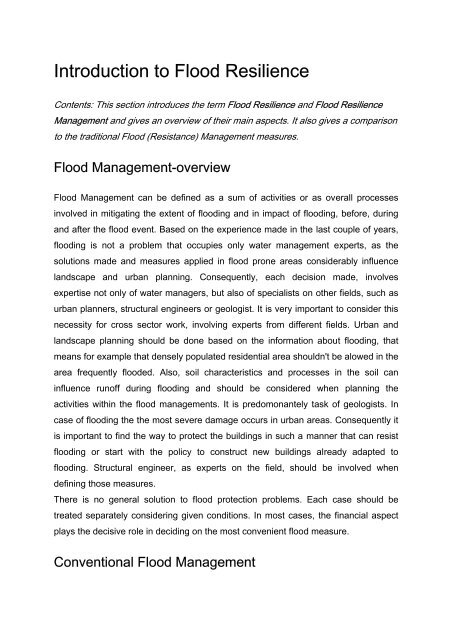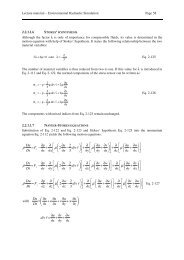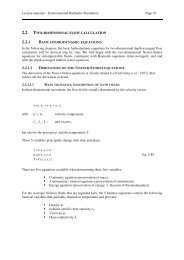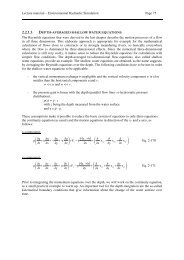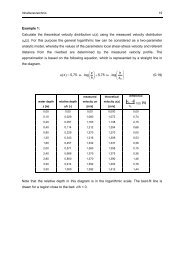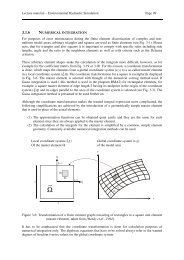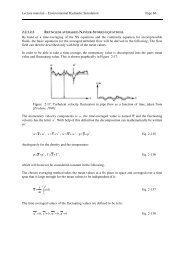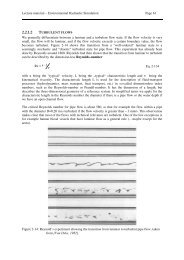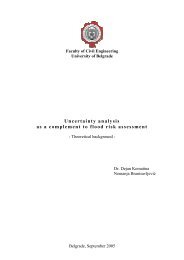Introduction to Flood Resilience - Flood Management
Introduction to Flood Resilience - Flood Management
Introduction to Flood Resilience - Flood Management
Create successful ePaper yourself
Turn your PDF publications into a flip-book with our unique Google optimized e-Paper software.
<strong>Introduction</strong> <strong>to</strong> <strong>Flood</strong> <strong>Resilience</strong><br />
Contents: This section introduces the term <strong>Flood</strong> <strong>Resilience</strong> and <strong>Flood</strong> <strong>Resilience</strong><br />
<strong>Management</strong> and gives an overview of their main aspects. It also gives a comparison<br />
<strong>to</strong> the traditional <strong>Flood</strong> (Resistance) <strong>Management</strong> measures.<br />
<strong>Flood</strong> <strong>Management</strong>-overview<br />
<strong>Flood</strong> <strong>Management</strong> can be defined as a sum of activities or as overall processes<br />
involved in mitigating the extent of flooding and in impact of flooding, before, during<br />
and after the flood event. Based on the experience made in the last couple of years,<br />
flooding is not a problem that occupies only water management experts, as the<br />
solutions made and measures applied in flood prone areas considerably influence<br />
landscape and urban planning. Consequently, each decision made, involves<br />
expertise not only of water managers, but also of specialists on other fields, such as<br />
urban planners, structural engineers or geologist. It is very important <strong>to</strong> consider this<br />
necessity for cross sec<strong>to</strong>r work, involving experts from different fields. Urban and<br />
landscape planning should be done based on the information about flooding, that<br />
means for example that densely populated residential area shouldn't be alowed in the<br />
area frequently flooded. Also, soil characteristics and processes in the soil can<br />
influence runoff during flooding and should be considered when planning the<br />
activities within the flood managements. It is predomonantely task of geologists. In<br />
case of flooding the the most severe damage occurs in urban areas. Consequently it<br />
is important <strong>to</strong> find the way <strong>to</strong> protect the buildings in such a manner that can resist<br />
flooding or start with the policy <strong>to</strong> construct new buildings already adapted <strong>to</strong><br />
flooding. Structural engineer, as experts on the field, should be involved when<br />
defining those measures.<br />
There is no general solution <strong>to</strong> flood protection problems. Each case should be<br />
treated separately considering given conditions. In most cases, the financial aspect<br />
plays the decisive role in deciding on the most convenient flood measure.<br />
Conventional <strong>Flood</strong> <strong>Management</strong>
Conventional flood management strategies which are targeting at the defense of<br />
these flood prone areas by dikes and walls are often not an adequate answer. In the<br />
past (up <strong>to</strong> 1950’s), dike heights were calculated on the basis of the maximum<br />
recorded water level. In practice this resulted in a raising of the dikes after each<br />
major flood. After that, an approach of establishing safety levels was adopted. The<br />
desired safety level was defined as the acceptable probability of flooding,<br />
corresponding <strong>to</strong> a “design discharge” having a certain occurrence probability.<br />
However, the design discharge is rising and expected <strong>to</strong> continue <strong>to</strong> rise, as a result<br />
of land use practices and climate change. Therefore, using the traditional approach<br />
<strong>to</strong> flood risk management, this would imply a further rising of the dikes. In general the<br />
investments for these defense structures can not be provided ad hoc. Additionally<br />
they will reduce the retention capacity of the river which needs <strong>to</strong> be compensated <strong>to</strong><br />
avoid increased flood risk downstream. However the possibilities for these<br />
compensation measures are limited. Looking for more economic and sustainable<br />
flood defense strategies, a great potential is seen in improved flood resilience of<br />
urban areas.<br />
An example of an urban area protected by dikes is depicted in Figure 1. Red line<br />
shows a part of the main dike line of the city of Hamburg, which is of considerable<br />
length and consequently this solution <strong>to</strong> flood problems, requires high investment.
Figure 1.1 Main dike line of the City of Hamburg<br />
[source(left): Behoerde fuer Inneres in Zusammenarbeit mit den Bezirksaemtern Hamburg-<br />
Mitte, Al<strong>to</strong>na, Bergerdorf und Harburg]<br />
<strong>Flood</strong> <strong>Resilience</strong> and Resilient <strong>Flood</strong> <strong>Management</strong><br />
In order <strong>to</strong> define the resilience, we are coming <strong>to</strong> the definition of RISK. The risk is<br />
defined as the probability or as a hazard that occurs and that creates a certain loss.<br />
Or:<br />
Figure 2 Definition of Risk<br />
The term <strong>Resilience</strong>originates from ecology and can be defined as the ability of a<br />
system <strong>to</strong> resist the perturbation or it is the speed the system recovers after being<br />
disturbed.
Resilient <strong>Flood</strong> Risk <strong>Management</strong> focuses on the ability of a system <strong>to</strong> resist the<br />
flood, taking in<strong>to</strong> account the consequences of floods. Applying the resilience<br />
strategies, decision maker does not try <strong>to</strong> "fight against floods" but <strong>to</strong> find the way <strong>to</strong><br />
"live with floods" by minimizing their impact.<br />
An area is more resilient if its vulnerability, i.e. potential damage of flooding is<br />
lower.Resilient <strong>Flood</strong> <strong>Management</strong> is based on minimizing the impact on flooding<br />
rather than improving the existing flood defense constructions. The underlying idea is<br />
<strong>to</strong> foster the ability of areas <strong>to</strong> recover after they had been proned <strong>to</strong> flood which in a<br />
general sense represents the resilience of a system <strong>to</strong> persist and absorb changes<br />
and disturbances.<br />
This implies that in a flood resilience policy flood damages have <strong>to</strong> be minimized and<br />
normal life has <strong>to</strong> return as soon as possible after flood. In agreement <strong>to</strong> ecological<br />
systems in which the rate of resilience is determined by many fac<strong>to</strong>rs, like variability<br />
of populations, their capability <strong>to</strong> adjust <strong>to</strong> the environmental conditions and <strong>to</strong><br />
repopulate, flood resilience <strong>to</strong>uches a variety of sec<strong>to</strong>rs and measures.<br />
<strong>Flood</strong> resistance strategies, on the contrary, focus on minimizing the probability of<br />
flooding.<br />
Figure 3 <strong>Resilience</strong>VSResistance<br />
In the last years many countries have released a new water policy <strong>to</strong> cope with<br />
floods, e.g. (LAWA 1995, BMU 2004, IRMA 2003). Instead of fighting floods it gives<br />
preference <strong>to</strong> strategies of living with floods which covers all measures of flood risk<br />
management by which the negative impact of flood is minimized. This change of<br />
paradigm is essential <strong>to</strong> find the optimal solution <strong>to</strong> flood problem nowadays.<br />
These measures can be subdivided in<strong>to</strong> four main groups:
• land use control<br />
• risk awareness<br />
• flood preparedness<br />
• financial preparedness<br />
<strong>Flood</strong> resilience is predominantly a matter of adequate land use. Thus spatial<br />
planning needs <strong>to</strong> consider flood aspects and has <strong>to</strong> define land use concepts for<br />
areas proned <strong>to</strong> flood which includes building regulations that are, building codes and<br />
zone ordinances or even prohibits certain forms of land use.<br />
Building codes and standards regulate the design, construction, use of building<br />
materials and maintenance of buildings in order <strong>to</strong> protect the users of a<br />
building.Building codes set the minimum acceptable requirements necessary for<br />
protecting people and their properties.<br />
Zone ordinances regulate landuse based on the flood hazard.<br />
Risk awareness encompasses all measures which fosters the risk perception of<br />
stake holders. The key issue in increasing the flood risk awareness is communication<br />
of the potential flood risk <strong>to</strong> affected citizen. While in the past, water authorities and<br />
communities were afraid <strong>to</strong> inform stake holders about their flood risk, the new water<br />
policy targets at full and open information about flood risk. Hazard and risk maps<br />
have been found <strong>to</strong> improve the risk perception considerably. Additionally, the<br />
methods <strong>to</strong> improve risk awareness are construction of flood marks/signposts,<br />
symbols and information centres, with the fundamental idea <strong>to</strong> make the symbols<br />
visible <strong>to</strong> everybody i.e. using public places for their .<br />
It is important that the information delivered <strong>to</strong> the people, appeals <strong>to</strong> the emotional<br />
level. This helps <strong>to</strong> reach people in a deeper and more lasting sense. Information and<br />
communication should always be clearly related <strong>to</strong> the local situation. This facilitates<br />
the identification of the people with the problem.<br />
<strong>Flood</strong> preparedness can be mainly influenced by methods of flood resistant building<br />
and hazard awareness. The flood resistance of buildings can be improved by<br />
retrofitting measures, such as holding back floodwaters through sealing the building<br />
or through barriers installed temporarily at some distance from a house (shielding). In<br />
case that a flooding of the building can not be prevented the flood resilience of a<br />
building can be improved by using waterproof materials and evacuation of the water-
sensitive interior of the building. Sealing as well as shielding of buildings and<br />
evacuation of the interior requires sufficient preparation time. Thus measures <strong>to</strong><br />
improve the flood resistance of building can be only effective if stakeholders are<br />
aware of the imminent hazard. This can be accomplished by flood forecasting and<br />
warning. However their reliability is strongly influenced by the quality of moni<strong>to</strong>ring<br />
systems and their promptness <strong>to</strong> transfer the recorded data <strong>to</strong> flood control centres.<br />
Another aspect of flood preparedness is certainly related <strong>to</strong> psychological problems<br />
following a flood. <strong>Flood</strong> damage usually implies losses of belongings sometimes of<br />
great personal value, that causes an emotional stress <strong>to</strong> the affected citizen. This<br />
aspect of flooding should be considered in advance with the objective <strong>to</strong>reduce the<br />
impact of this experience through communication policy and instructions for proper<br />
action.<br />
Also, the recovery after flood can be accelerated by damage compensation<br />
regulations and insurances.<br />
Table 1: <strong>Resilience</strong> Strategies-Main groups of activities with corresponding<br />
responsibility<br />
Land Use Control<br />
I) Spatial Planning<br />
<strong>Flood</strong> risk adapted land use<br />
II) Building regulations<br />
Building codes<br />
zoning ordinances<br />
Public Responsiblity<br />
Risk Awareness<br />
I) Information:<br />
Inundation maps<br />
Risk maps<br />
II) Education<br />
Learning Groups<br />
Brochures<br />
Public and Private<br />
Responsibility<br />
<strong>Flood</strong> Preparedness<br />
Financial<br />
Preparedness<br />
I) <strong>Flood</strong> resistant buildings<br />
Waterproof materials<br />
Sealing of buildings<br />
Shielding of buildings<br />
II) Hazard Awareness<br />
Forecasting and Warning<br />
of flood hazards<br />
Emergency measures<br />
Obliga<strong>to</strong>ry insurance<br />
Private insurance of the<br />
Public and Private<br />
Responsibility<br />
Private Responsibility
emaining risk<br />
As it has already been shortly induced, integrative approach is the key word for<br />
deciding on flood resilience measures.<br />
For example, without land use control and risk awareness the efficiency of flood<br />
preparedness will be limited. Without risk awareness the readiness of stakeholders <strong>to</strong><br />
invest in an improved flood resistance of their building is limited. Inconsistent land<br />
use can lead <strong>to</strong> inefficiency of flood preparedness or higher investments <strong>to</strong><br />
accomplish flood resistance of the building.<br />
In England even a Kitemarking institution for approving techniques and materials of<br />
flood resilience has been established. In Germany many Governmental agencies and<br />
municipalities have delivered brochures <strong>to</strong> the stakeholders in which they inform<br />
about the risks of flood and possibilities <strong>to</strong> adapt their buildings <strong>to</strong> flood. However<br />
little is known about the efficiency of those measures either for individual properties<br />
or groups and <strong>to</strong>tal urban districts of communities. On this basis the benefit of flood<br />
resilience can not be evaluated in an economic way. The economic soundness of<br />
flood resilience compared <strong>to</strong> alternative flood defence concepts (e.g. conventional<br />
methods of defence by dikes and walls) can not be proved and stakeholders have<br />
difficulties <strong>to</strong> realize the payback and limits of their investments. Thus the Technical<br />
University of Hamburg, Germany has carried out an investigation in which the<br />
observed damages have been analysed in 9 communities along the river Rhine,<br />
Elbe, Danube and their tributaries with the objective <strong>to</strong> quantify the damage due <strong>to</strong><br />
insufficient flood resilience. The work was done by order of the International<br />
Commission for the Protection of the River Rhine (ICPR) which published some of<br />
the results in (IKSR, 2003). For the first time it could be quantified in what way flood<br />
awareness influences the construction of the fabric and interior of buildings and what<br />
damage can be reduced by different measures of flood resistance at buildings.<br />
In order <strong>to</strong> get better overview of the main characteristics of resistance and resilience<br />
strategies, a short summary is given in Table 2.
Table 2: Comparison between Resistance and <strong>Resilience</strong> Strategies<br />
Resistance strategies<br />
One design discharge is applied for the whole<br />
area, implying that all land use types (e.g.<br />
cities, agricultural areas and nature reserves)<br />
have the same probability of flooding.<br />
Applying one safety level also means that it is<br />
unknown which area will be flooded.<br />
Little attention is given <strong>to</strong> the consequences<br />
of possible floods. As a result of economic<br />
development, the potential flood damage has<br />
increased significantly. The resistance<br />
strategy creates a false sense of safety which<br />
explains why large investments are still being<br />
made in the area. As a consequence, the<br />
economic value at risk of flooding still<br />
increases steadily<br />
It causes an endless need for raising and<br />
improving the water defence structures, thus<br />
restricting the natural dynamics of a river<br />
system and spoiling landscape qualities such<br />
as cultural heritage and scenery.<br />
<strong>Resilience</strong> strategies<br />
Focus on reducing the impact of floods by<br />
"living with floods" instead of "fighting<br />
floods", as in the traditional strategy. They<br />
aim at giving room <strong>to</strong> the floods but with<br />
concurrent impact minimalization.<br />
Consider measures <strong>to</strong> reduce the impacts of<br />
flooding, such as the design of warning<br />
systems and evacuation plans and the<br />
application of spatial planning and building<br />
regulations.<br />
May also include measures <strong>to</strong> accelerate the<br />
recovery after a flood, such as damage<br />
compensation regulations and insurances


